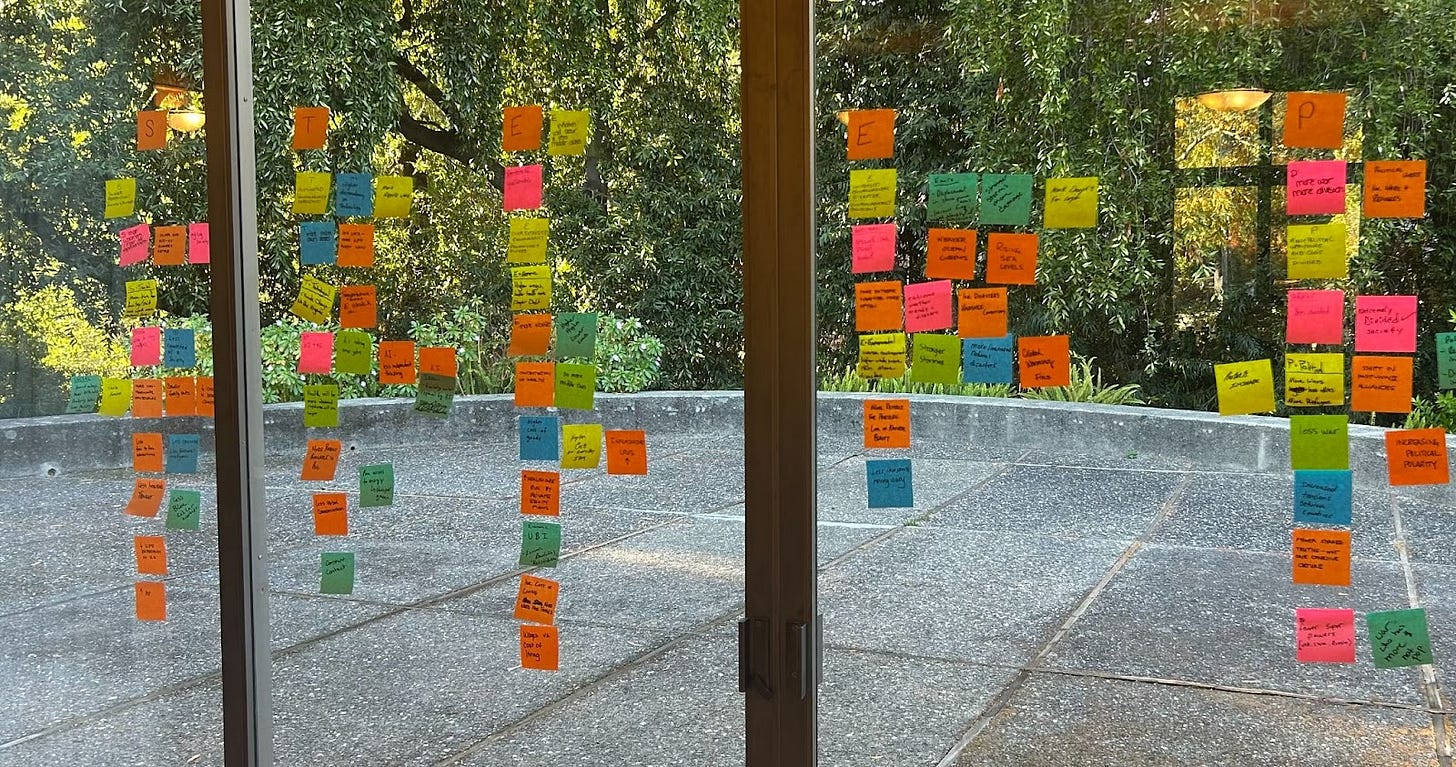Creating Islands of Sanity* at Work

Recently, I taught a course called Leading in the Era of Perpetual Upheaval as part of an Executive Education certificate program for mid- to senior-level professionals. We used the BANI framework — Brittle, Anxious, Nonlinear, Incomprehensible — created by Jamais Cascio to explore the chaotic conditions we are all navigating now, paired with STEEP analysis to generate data for future scenarios set in 2035:
S - Social Demographic, cultural trends
T - Technological Innovations, automation, new platforms
E - Economic Business market conditions, global financial health
E - Environmental Climate conditions, climate change impact, sustainability consciousness
P - Political Policy, trade, regulatory and governmental stability
Reader, things got real dark, real quick. Though there may have been a few hopeful ideas about the future on our wall of sticky notes, the prevailing vision included a future of less human connection, more technological automation, greater economic stratification, and larger, more devastating climate events.

After we joked around a bit and took a couple of collective, deep breaths, I asked participants to work through three different scenarios centered on this challenge question:
What will your job role or industry be like in 10 years?
Most likely
Worst case
Best case
They described the future through either the likely, worst, or best case lens as well as the the leadership skills and strategic responses necessary to navigate this future. Extra credit for drawing a picture representing their scenario.
We then looked across each of these three scenarios to identify shared trends and drivers, the common, necessary leadership skills and strategies, and beneficial “no regrets” actions to take regardless of the future that unfolds.
Multiple diversity dimensions existed among these sixteen people, including gender, ethnicity, industry, education levels and, undoubtedly, many more that were not revealed, including the high likelihood that not everyone voted for the same candidate for president in 2024.
One common thread emerged: Every person in that room yearns for a future with more connection, greater belonging, increased empathy, and free flowing compassion. These qualities were seen not only as desirable, but essential, leadership traits for navigating an uncertain future.
Given that the average person spends 90,000 to 100,000 hours at work over their lifetime - roughly one third of a person’s awake time! - this is where we do a lot of our interacting, relationship building, learning, and skill building. Research and experience show that people do their best when they feel psychologically safe in an environment defined by care. A culture that allows individuals to be fully human—not just employees—yields the greatest contributions.
Leaders set the tone for organizational culture, influencing how people show up and contribute. If you’re in a position of leadership, consider these actions to create “islands of sanity” in your sphere:
Foster an environment of trust and openness.
Allow vulnerability and genuine human connection.
Encourage empathy and active listening.
There are lots of ways to foster, allow, and encourage this type of environment. Here are some concrete suggestions - take one or two that work for your context and try them out:
Foster an environment of trust and openness:
Hold regular one-on-one check-ins focused not just on tasks but on well-being.
Model transparency by sharing your challenges and how you address them.
Recognize and reward acts of empathy and collaboration - not just work output - in the team.
Allow vulnerability and genuine human connection:
Create spaces for team members to share personal stories, such as diversity dimensions important to their identity.
Normalize asking for help and showing support for colleagues.
Integrate reflective practices or mindfulness exercises into meetings to ground the team.
Encourage empathy and active listening:
Train teams in effective facilitation techniques, ensuring everyone contributes and every voice is heard.
Lead by example by listening without interrupting or judgment. Ask clarifying questions such as, “tell me more about why you think that / how you got there?”
Promote open dialogue sessions where diverse perspectives can be shared and discussed constructively, such as project retrospectives.
Business is human. While we may not be able to directly influence global politics, we can cultivate workplace cultures where care and connection are valued, turning the workplace into an island of sanity amidst chaos, where people can truly thrive.
* Margaret Wheatley coined the phrase “islands of sanity” to describe workplaces with healthy relationships where good work gets done in Who Do We Choose To Be? Facing Reality | Claiming Leadership | Restoring Sanity



Good suggestions for action steps! The future is brighter than this - hopefully!! And uncertainty is better faced together than alone. I think the current, rule based, tightly monitored hybrid work environment with mandated office days is working against the purpose of tighter connections and better work communities and communications. It allows people to detach and not be in tune with how everyone else is really feeling. I wish more companies went back to how it used to be: everyone is expected to show up in person every day except when life intervenes… doctor visits, sick kids, occasional volunteering, car breakdowns, work travel days, etc. My team used to average 3.5 days in the office before the pandemic with no stated rules.. but everyone showed up when workload was heavy, and teams aligned their own schedules. No guaranteed remote days. Now more and more people are adjusting their child care and commutes with the expectation of guaranteed remote work days. That sounds better for the individual in the short run, but the community suffers.
Thank you Robin. I found this line inspiring. One common thread emerged: Every person in that room yearns for a future with more connection, greater belonging, increased empathy, and free flowing compassion. These qualities were seen not only as desirable, but essential, leadership traits for navigating an uncertain future.